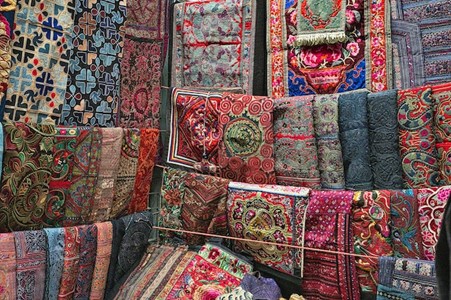Jennifer L. Boyd of Seabrook is a Registered Nurse working in Women’s Health and also an avid quilter. Jennifer Boyd enjoys learning the stories behind the patterns and designs of various quilters and in the following article she shares some background on this very American art form.
Both traditional and modern-made quilts tell wonderfully in-depth stories to those who care to listen. They're snapshots of the lives and environments of their makers, capturing times, places, circumstances, and events. From family heirlooms to museum-based masterpieces, quilts provide rare insight into the lives of those who wandered the earth centuries ago.
Jennifer Boyd of Seabrook says that their significance throughout the nation (and indeed the world) has become unparalleled. But the American quilt actually began as what Quilting in America calls
"an art of necessity."
Quilting for Warmth
Women in the early American colonies used all sorts of materials to keep their loved ones warm throughout the winter — they simply didn't have time for artistic endeavors.
When blankets became worn, they were patched, used as filler, or combined with other blankets in better condition. They were strictly utilitarian and not carefully crafted heirlooms.
Jennifer Boyd of Seabrook explains that it was only when fabrics were domestically manufactured and became more affordable for the average person that creativity in quilting flourished.
Quilts fashioned between 1750 and 1850 were patched, pieced, and preserved. Some were so incredibly elaborate that it's understandable why they're cherished within families and/or museums, providing insight into the lives of people's ancestors.
Pictures Say 1000 Otherwise-Unsaid Revolutionary Words
As anyone who has wandered the halls of an art museum or exhibition will know, precious quilts depict various scenes, patterns, and people — all of which tell stories to those who lay their eyes upon them. But it isn't just about the imagery expertly sewn or applied to the front of the quilt; it's also about the materials the quilter chose to use for their creation.
An exhibition called
Radical Tradition: American Quilts and Social Change showcased around 30 quilts from traditional to contemporary artists, wherein each had something politically important to say. For example, one contained a panel crafted from suit fabric by survivors of the Dachau concentration camp. Another, dubbed
The Storm, the Whirlwind, and the Earthquake, depicted a life-size portrait of Frederick Douglass, the abolitionist.
More recently, Jennifer L. Boyd of Seabrook says that quilts re-surfaced in a bid to pour the fear of the coronavirus pandemic. The museum, which hosted the exhibition, organized a virtual quilting bee during the lockdown, wherein people from around the country submitted roughly 100 quilt squares. Organizers then virtually stitched the squares together, crafting a beautiful yet emotionally fraught quilt.
Just like the quilts made thousands of years ago to ensure future populations remember the past (good and bad), this modern-day relic will undoubtedly hold just as much historical significance.
It's exhibitions like these that display the art of quilting as far more than a utilitarian warmth provider. Artists capture deep emotions, political points, events, and so much more within the fabric explains Jennifer L. Boyd of Seabrook.

 Quilts Boast Personal Historical Significance Too
Quilts Boast Personal Historical Significance Too
Quilts can showcase milestone moments in American history, give marginalized communities their voices back, and ensure political views are heard. However, they can also hold sentimental value and interesting information about individuals' ancestors. While such quilts may not be adored by the nation, they mean the world to those closest to them.
A 2016 show, A Patchwork of History Handed Down, saw Peggy Whitlow offer several of her family's quilts to talk about their significance. According to the Michigan City native, the stitched masterpiece displays her relative's history as they were liberated from slavery and headed north.
Jennifer L. Boyd of Seabrook reports that it was this beautiful heirloom that inspired Whitlow to create her own quilts to give to her children upon her passing. The first quilt she ever crafted was for Tre, her son, to reflect his time on the high school basketball team.
At the show, she added that she wasn't necessarily thinking about the history it held at the time. However, hindsight is 20/20, and she can now see the rich roots within her stitches.
Traditional Quilters May Have Thought the Same
Although no one can truly and accurately estimate the thoughts running through long-since-passed quilters' brains, they might've thought the same thing as Whitlow when crafting their honored creations.
Jennifer L. Boyd of Seabrook says that while some certainly put a lot of thought into depicting their politically straight-talking or descriptive blanket, it's interesting to consider the possibility of little to no creative direction. After all, humans don't know they're making history until they've made it.

 Quilts Boast Personal Historical Significance Too
Quilts Boast Personal Historical Significance Too